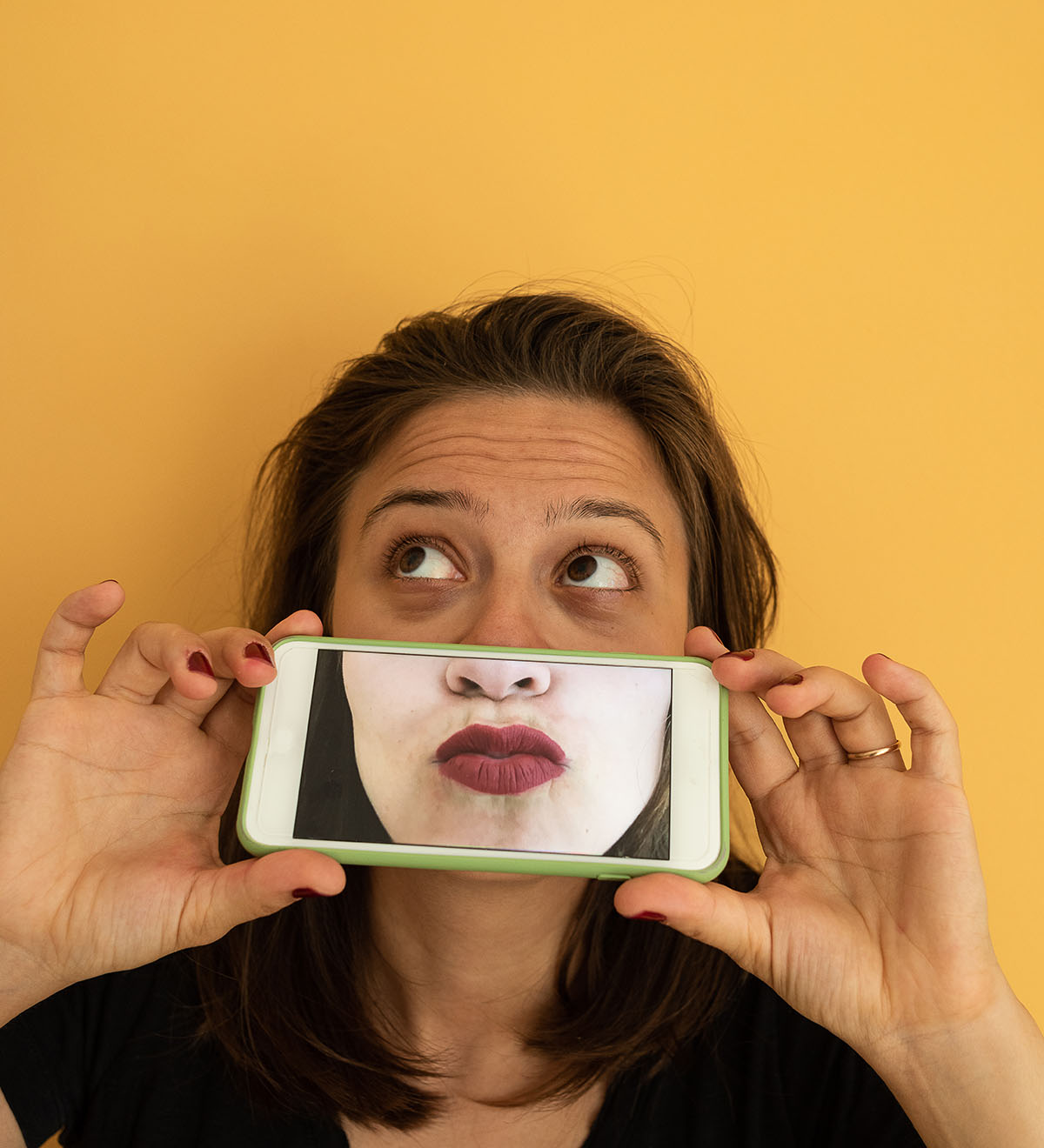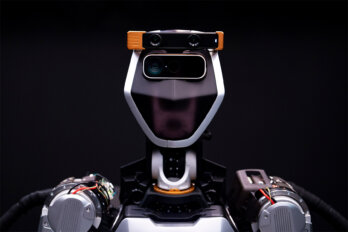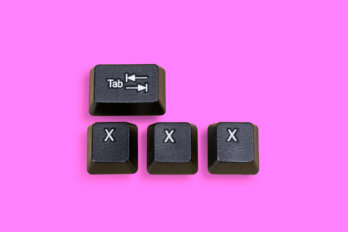I came across a TikTok recently that articulated something about my face I’d been struggling with. It was one of those videos where the speaker sits in the front seat of her car as if she’s been so overcome by an epiphany that she had to pull over and share. In this one, the thirty-seven-year-old user, @lesswastedliving, expresses bewilderment at her struggle to recognize her changing face in the images she produces nearly every day. “It’s just odd to seek yourself in the mirror or on camera and not being able to find it and having to become okay with this new person,” she says.
I understand how she feels. Since my fortieth birthday, I’ve found it increasingly difficult to take good selfies. It’s not so much an issue of wrinkles or grey hairs—although I have both. It’s that the muscles of my face are weakening. To keep my eyes from drooping before I hit the button, I pop them open wide and come out looking surprised, even a bit manic. Though I’ve recognized small changes in my face before, this is the first time they’ve challenged my photography skills. With each new shot, I wonder: Who is this woman that I’m trying to capture?
Endless pages have been written about the cultural meaning of the selfie—whether it represents the essential vanity of millennials and Gen Zers or, as many feminists have argued, it offers a vital source of self-definition that short-circuits the male gaze. A large chunk of research done on selfies focuses on the effects they have on the self-esteem of teens and young adults, periods of life that were already marked by self-consciousness long before filters came along to confuse things.
There is far less research on the long-term effect of this behaviour: how taking and sharing selfies over a period of decades affects a person’s perception of aging or time itself. Women around my age—those of us who live on the line between baby Gen X and elder millennial—are watching our identities shift in real time in a way no previous generation has experienced en masse.
This proliferation of images calls to mind the work of Taiwanese artist Annie Wang. In 2001, the day before her due date, Wang took a photograph of herself sitting on her bed, with the words “My Belly / My Baby” written on her bare midriff. That image was the beginning of a series called “The Mother as a Creator,” where, over time, she photographed herself and her son every year or every few years with the previous portrait in the background. Wang has called the resulting mix of images, the most recent of which was taken in 2022, a “time-tunnel” in which the past and present all seem to exist simultaneously.
The project is a powerful statement about the erasure of women from the art world once they become mothers, but I’m also drawn to its frank depiction of a woman’s face as she ages. While the most dramatic changes appear in her son as he goes from toddler to young adult, I linger on the relatively subtle movement of time in Wang’s face over twenty years. Lines develop around her eyes and mouth, her hair and mood change—evidence of a life.
To age on the internet is to exist in an accidental version of Wang’s time tunnel. In my social media archives and in profile photos, I encounter previous versions of my face every day. Past and present exist simultaneously, making the self that once seemed unified appear fragmented into a series of slightly different faces.
I posted my first selfie on Instagram in 2013, the year that “selfie” was declared the word of the year by Oxford English Dictionaries. I took it in a salon mirror, my hair sticking out in foils while the hairdresser who encouraged me to adopt Instagram checked to see if the bleach had done its work. Before that, the selfies I posted on Facebook or used as profile photos had always been of the finished product, but Instagram felt fleeting enough that I could post it as a joke for my small number of followers. It was my opening salvo in a conversation that has lasted a decade.
Though I was already in my early thirties, Instagram was the first place I can remember feeling a sense of shared celebration around my appearance. We tend to divide women into attractive and unattractive and assume the former category is too visible while the latter is invisible. My experience has never been that clear-cut. I’m not traditionally attractive by our society’s narrow standards (the word “cute” is occasionally thrown my way), but I’ve experienced both unwanted attention and the feeling of fading into the background.
In posting selfies, I was able to command that visibility on my terms and for my pleasure. I began sharing my hair-colour experiments, enjoying the rush of likes when I went deep blue or bright purple. Changing my profile photo became an event. I came to know how I wanted my face and body to be seen and gave my image the same care and attention I’d been giving the photos I’d been taking of friends since I got my first film camera as a teenager.
Somewhere in the background was that other Instagram, the one dominated by thin, wealthy influencers that Jia Tolentino writes about in her 2019 New Yorker essay “The Age of Instagram Face”: the celebrities who all look the same, the ones who “alter photos out of a simple defensive reflex, as if FaceTuning your jawline were the Instagram equivalent of checking your eyeliner in the bathroom of the bar.” But that wasn’t my community. It was play I craved rather than perfection.
Likewise, the people I followed on Instagram had faces and bodies that weren’t often celebrated in media—people who aren’t white, straight, thin, rich, and able bodied. Sometimes they played with makeup in wild, theatrical ways, and other times they captured themselves from purposefully awkward angles to confront the expectations of the form. I was hungry for this variety of faces.
The more I shared, the more my archive grew, but unlike the prints of my childhood photos, these digital shots don’t bleach with time or curl at the edges. They look the same as on the day I took them. I, on the other hand, have changed a great deal in ways that are all the more obvious because of that archive.
A few weeks after her first post, the woman on TikTok came back with an update for her image problem: part of the solution, she claimed, is to learn more about skin care. I understand the urge. For many women, to enter middle age is to face a well-documented slide toward invisibility, a loss of the small amount of power that comes with youthful beauty, and acting against it feels like a moral imperative.
There is no shortage of options for the modern woman seeking to stop time. One skin care clinic in my neighbourhood has green walls that recall a nineteenth-century sanatorium. For a few hundred dollars, they’ll shoot me full of plumping agents, inject me with hyaluronic acid or Botox, and grind off my dead skin with diamonds to reveal the baby underneath, freezing me in time or even reversing it. If it weren’t for lifelong allergies, I may have already walked through that door.
In her book The Beauty Paradox: Femininity in the Age of Selfies, Université du Québec à Montréal professor of sociology Chiara Piazzesi calls this “successful aging.” Women, she writes, “are constantly confronted by a discourse that says that the passage of time, and its effects on their bodies, is a problem, a challenge, a nuisance that they must successfully confront—which means aging as little, as slowly, as invisibly as possible.”
Through interviews with eleven women of various ages, Piazzesi explores the meanings of beauty in an age where digital photography underpins and expresses our identities. According to her subjects, selfies now figure into the aging process in multiple ways. They can be a source of positive attention, which is rare for older women; they can help women cope with the process of aging through flattering self-portraits; and they can provide a “visual journal of one’s gradual bodily transformation, hence entailing a materialization of the fading of beauty over time.”
We see these uses on social media in the selfies of celebrities for whom aging is apparently a source of terror and fascination. Some use the medium to defy time or shoot back at critics. Martha Stewart juts her chin and pouts in her shots, somehow looking more fifty-something than eighty-two. After being pilloried for noticeable plastic surgery at the Grammy Awards in 2023, sixty-five-year-old Madonna posted a selfie of her face with the caption “Look how cute I am now that swelling from surgery has gone down.”
Others use selfies to reveal the small details of their aging process that we rarely see in movies and television. Gillian Anderson is a master of the form; in one video diary, she’s resting her head on her hotel room pillow after a long day of filming, grey roots peeking out of her trademark strawberry blond, the lines on her forehead and under her eyes marking every one of her fifty-five years. It feels intimate and comforting to see that a woman long admired for her beauty is aging too. But even her graceful version of the journey through middle age seems like an impossible ideal. These are the selfies of people who have seemingly infinite aesthetic budgets, people whose appearance is their livelihood.
What templates exist for the rest of us? For a more relatable “visual journal” of the body aging, I look to women artists who have explored time through self-portraiture. There’s the series of sixteen self-portraits by Finnish artist Helene Schjerfbeck, beginning as a stern twenty-two-year-old in 1884 and ending as a wraith-like sketch in 1945, a year before her death at eighty-three. Or the work of American artist Cindy Sherman, who has been interrogating our culture’s relationship to gender and photography for decades. Her most recent collection of playful portrait-like digital photo collages exaggerates the stretch of pores or the bleed of lipstick into wrinkles, all the details that women are expected to hide. Like me, these artists are less interested in beauty than in confronting the steady, ineluctable impact of time.
Perhaps it’s not the loss of beauty the TikTok influencer and I fear so much as a slide into irrelevance. After all, the internet is a land ruled by the young. In my lifetime, I’ve already seen and adapted to the rise of so many world-changing technologies, from the arrival of home internet in my teens to the birth of social media in my twenties and the rise of artificial intelligence in my forties.
Each new way of communicating has brought with it a complex negotiation of social assumptions that glorifies those on the cutting edge while relegating those who fall behind to irrelevance and ridicule. Just think of the endless TikToks pillorying millennials who use duck face in their selfies or the Gen X habit of lifting the camera high enough to hide eye circles and sharpen the chin.
The style of my selfies hints at their age—the low resolution of my old iPhone camera, the out-of-style grainy film filters. University of Waterloo associate professor Aimée Morrison, who has long studied the selfie as a form of communication, articulates this pressure to remain up to date. “It’s okay for me if I look old, but I don’t want to look clueless,” says Morrison. “I don’t want to look like I don’t know how to take a picture.”
She agrees that, with the rise of video, selfies are no longer the internet’s lingua franca. But we still need them to communicate in other ways. There is an expectation, for example, that we update our profile photos regularly or risk being seen as dishonest. “You can put a photo of yourself when you’re twelve, and that’s fun,” she says. “But you can’t be forty and have a picture up from when you were thirty-five, because now you’re a forty dressed up as a thirty-five. There’s some kind of fakery going on there.”
This is true in my work as a university instructor, where so much of my interaction with colleagues and students now happens online. I have an avatar in Zoom for when my camera is off and ones for WhatsApp and Slack. I even have a selfie profile photo in the course management software that my students see every time I post. Keeping these up to date has begun to feel like a part-time job.
I’ve noticed that a few of my contacts have begun to use AI selfie generators to opt out of this altogether. Instead of a candid shot, apps like Lensa offer faux artistic portraits at a tiny fraction of the cost of a human artist. Ethics aside, I can see why this is an attractive option.
Out of curiosity, I uploaded the requisite ten recent images of my face and waited for the Lensa app to do its work. The result was a collection of women’s faces in a variety of styles—sci-fi landscapes, anime, fairy princesses, etc. I could see my nose here, my eyes there, but most of them only vaguely resembled highly idealized versions of me. They were younger, thinner, and more symmetrical than I am. They had big pouty lips where mine are small and thin, and their skin was smooth and creamy where mine has freckles, scars, and lines. Several resembled younger versions of Drew Barrymore or Kirsten Dunst. One bore a striking resemblance to a Boys for Pele–era Tori Amos.
Looking at this selection of cultural signifiers the app had plucked from the internet, I felt a familiar disappointment. This was not the unified self I was looking for. It didn’t even have that frisson that comes from having someone photograph me. If anything, it exaggerated my distance from that thirty-something I’d captured in the salon mirror and from those cultural ideals of beauty I’d always pushed against.
This made me think of a self-portrait by Emily Carr I’d seen recently at the end of an exhibition titled Uninvited: Canadian Women Artists in the Modern Moment at the Vancouver Art Gallery. After wall upon wall of images by and of women who had been excluded from the visual culture of their time, the small painting of the artist at sixty-seven years old struck me hard.
In it, Carr’s eyes are severe, discerning. Her cheeks and mouth are covered in lines that imply both wrinkles and a lifetime of movement. Her body takes up more than half the picture frame. Carr hated painting portraits and hated her aging body, but I can’t help seeing the power of her presence, how she makes herself as formidable as she might a mountainside in one of her famous landscapes. Carr doesn’t jut out her chin and pout. She doesn’t cringe in horror or tear up over the loss of beauty. She stares back at the viewer, one eyebrow slightly raised.
“To paint a self-portrait should teach one something about oneself,” Carr once wrote. I’m no painter, but if I continue to take selfies as I get older, maybe I’ll come to accept the changing landscape of my face rather than fear it.





